Quick Bible for Android
Let me introduce a free app, Quick Bible, for any Android users. You may download it from Google Play. This app features all the function you need to read and study the Word of God including:
- bookmarks verses
- writing personal notes
- highlights text
- progress markers
- split screen reading on two bible translations: side by side OR top and bottom view allowed
- comparing single verse among all installed bible translations

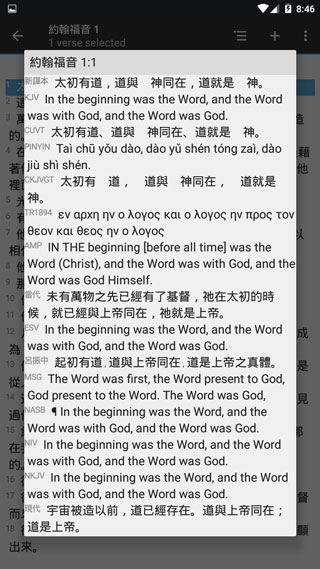
- show cross reference on some translations
- find words and phrases with advanced features
- various reading plans can be downloaded to fit your need
- devotional material, Morning & Evening by Spurgeon, is included
- all the Bible text and devotional can be copied and shared to other app
- song books function allows to display hymn lyrics and listen to music when online
- different languages and translations can be downloaded directly on your phone for offline reading
What's more?
The beauty of this app is that you can import your own bible translation. It accepts Bible+ module .PDB file and its native .YES file. Here is how you can import your own bible translation.
Step 1: Prepare or download a PDB that you want to import.
Step 2: Put the PDB file to a folder on your Android device. Remember this folder location, you will be ask in the latest process. Note: the PDB will be read from this folder and you may delete it after the installation.
Step 3: Go back to Quick Bible app. Click the translation pull-down menu.

Step 4: At the bottom of the list, click OTHER VERSIONS.
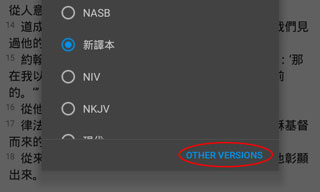
Step 5: Click "+" inside the Manage Versions window.
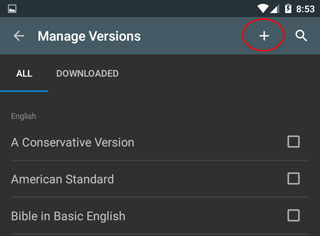
Step 6: Click "From local storage" for this installation. "From Internet URL" is ONLY be used for .YES native module.
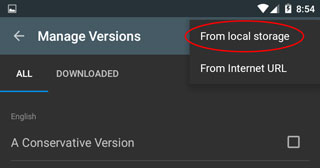
Step 7: Click and locate the PDB storage folder.
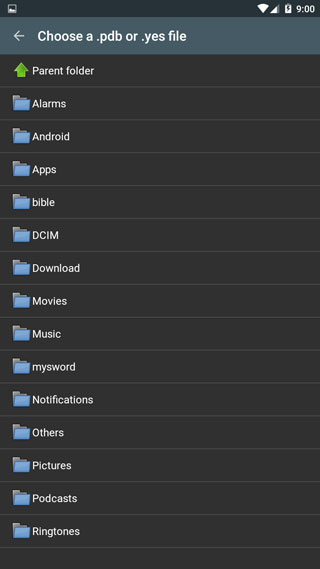
Step 8: Inside the PDB files folder, select the bible translation you want to install.

Step 9: If you are install Chinese bible, you may see gibberish sample text like the screen below. Click the PDB encoding pull-down menu.

Step 10: Select the right encoding for your PDB. For Chinese Traditional font, use Big5 or Big5-HKSCS. For Chinese Simplified font, use GBK. UTF-8 encoding is usually fine for English, However, if the particular translation uses special character like ¶, you may want to use ISO-8859-1 instead.
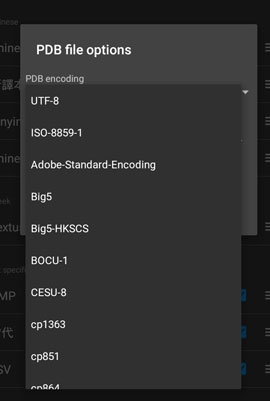
Step 11: Check the sample text. If all is fine, click OK to continue.
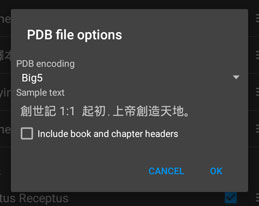
Step 12: You will see the app importing the PDB. When it is complete, you will be return to Manage Versions window under DOWNLOADED tab and you will see your new imported bible. You may import another bible translation from step 5, otherwise, you may exit the menu and start reading your new imported translation.

You may download the Bible+ modules from this website and import it today.
Traditional Chinese/繁體字 (Big-5) Bible Version:
| Chinese Union Version in Original Word and Punctuation (和合本舊標點版) |
| Chinese Union Version in New Punctuation(Modified from Original CUV) (和合本新標點版) |
| Chinese Union Version with Footnoted Strong's Number (和合本加入Strong編號版, 可配合以下原文字典使用) (see notes for details) |
| Chinese PinYin Bible based on Chinese Union Version (和合本漢語拼音版 ) |
| Chinese Lu Chen-Chung Traditional (呂振中譯本) |
These modules are available in HERE
Note:
- Strong's Numbers in ( ) indicates Tenses and Verbs. " " indicates this word is not translated into Chinese word.
Simplified Chinese/简体字 (GBK) Bible Version:
| Chinese Union Version in Original Word and Punctuation (和合本旧标点版) |
| Chinese Union Version in New Punctuation(Modified from Original CUV) (和合本新标点版) |
| Chinese Union Version with Footnoted Strong's Number (和合本加入Strong编号版, 可配合以下原文字典使用) (see notes for details) |
| Chinese PinYin Bible based on Chinese Union Version (和合本汉语拼音版) |
| Chinese Lu Chen-Chung Traditional (吕振中译本) |
These modules are available in HERE
English Bible Version:
| 1769 King James Authorized Version with paragraph indication and Footnoted Strong's Numbers as well as Reference Notes (Can be used with Bible Lexicon) |
| 1769 King James Authorized Version with Words of Christ in Red and Footnoted Strong's Numbers |
| A Conservative Version, by Dr. Walter L. Porter |
| American King James Version, by Stone Engelbrite |
| American Standard Version with footnotes and paragraph indication |
| Bible in Basic English (1949/1964) |
| Bible in Worldwide English (BWE) with paragraph indication |
| Darby Bible (1889) with paragraph indication |
| Douay-Rheims American Edition (1899) |
| Douay-Rheims Bible, Challoner Revision |
| Hebrew Names Version with footnotes and paragraph indication |
| Literal Translation of the Holy Bible, by J. Green |
| Montgomery New Testament (1924) with paragraph indication |
| Murdock Translation with footnotes and italic indication |
| Restored Name King James Version with footnotes, paragraph and italic indication |
| Revised King James NT, 2000 Edition, edited by Brad Haugaard |
| Revised Standard Version with paragraph indication, requires agreement signup |
| Revised Webster Version with Strong's Number, morphology codes, footnotes and paragraph indication (Can be used with Bible Lexicon) |
| The Common Edition New Testament with paragraph indication |
| The Emphasized Bible with paragraph, italic, underline and cite indication |
| The Living Oracles NT with paragraph and italic indication |
| Twentieth Century NT with footnotes and paragraph indication |
| Tyndale Bible |
| Webster Bible with "not in original text" indication |
| Weymouth NT with paragraph and cite indication |
| World English Bible with footnotes, paragraph and italics indication as well as formatted text |
| World English Bible with Words of Christ in Red. |
| Young's Literal Translation with paragraph indication |
These modules are available in HERE
Interlinear Greek Bible Version:
| Septuagint LXX Greek Old Testament with Footnoted Strong's Numbers and complete parsing information (Can be used with Bible Lexicon and Morphological Analysis Codes) |
| Combined Greek New Testament Manuscripts: 1550 Stephens Textus Receptus (T), 1894 Scrivner Textus Receptus (S), Byzantine Majority (B) and Alexandrian (A) |
| 1991 Byzantine/Majority New Testament with Footnoted Strong's Numbers and complete parsing information (Can be used with Bible Lexicon and Morphological Analysis Codes) |
|
1550 Stephens Textus Receptus, 1894 Scrivener Textus Receptus with Footnoted Strong's Numbers and complete parsing information (Can be used with Bible Lexicon and Morphological Analysis Codes)
|
| Interlinear Greek New Testament with Footnoted Strong's Numbers (Can be used with Bible Lexicon and Morphological Analysis Codes) |
| Westcott-Hort New Testament text from 1881, combined with the NA26/27 variants, with Footnoted Strong's Numbers and complete parsing information (Can be used with Bible Lexicon and Morphological Analysis Codes) |
These modules are available in HERE
Note:
- Please rename the pdb file starting with "z_" for Greek to display correctly. For example, xignt.pdb -> z_xignt.pdb. However, the Morphological Analysis Codes may not display correctly.
- If anyone doesn't want to display Greek but Roman instead, one can just download and use the file directly.
- For Greek Parsing Syntax, you can reference it from here.
- Variants readings in Westcott-Hort are given in the text in this presentation: | Westcott-Hort | NA-26 |. Doubtful text is indicated in " ".